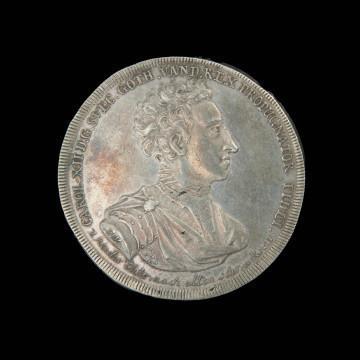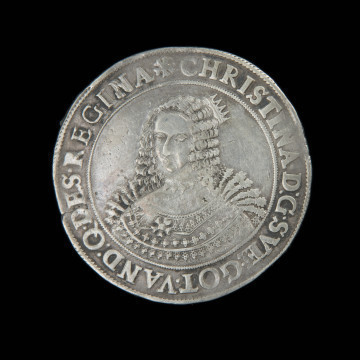
The thaler on the occasion of the establishment of religious freedom in Silesia
1709
National Museum in Szczecin
Part of the collection: Pomeranian coins
The reign of King Charles XI (1660-1697), despite the monetary chaos, was marked by exceptionally numerous gold issues. Until the war with Brandenburg (1674-1677), Sweden did not show much interest in monetary matters in Pomerania. The mint in Szczecin was leased, and the minting of silver coins was not profitable due to the high price of silver. In 1682-1684, a radical reform of Pomeranian minting took place, a provincially controlled management was established, and a new type of thaler, called the chanter (worth 2/3 of a thaler, minted at a reduced minting rate) served to stabilise coinage. The system modernisation did not change the appearance of the coins minted in Szczecin. The griffin dominated on small denominations, and the portrait of King Charles XI in a wig and laurel wreath stood out on the stamps of thick silver and gold coins. The reverses of thalers and ducats were decorated with a crowned, nine-pointed coat of arms of Pomerania in a full-frame. In the early 1790s, a non-standard type of rare two-ducats appeared as manifestation and propaganda issues. On the obverse, the ruler is presented in a luxuriant wig (an influence of the French coins of Louis XIV) and barely visible armour, on which a paludamentum (a Roman military woollen cloak) is imposed, fastened at the shoulder. The bust occupies most of the stamp area, interrupting the legend, creating an impression of monumentality. The royal status of Charles XI is emphasised by the short royal titles, without the traditional Pomeranian ducal title. The visible ICA initials refer to the mint master Julius Christian Arenburg, who held this office in 1695-1698. The reverse has an original and highly ornamental composition, consisting of a sheaf of grain and the crown insignia lying above it. The image, together with the motto ET REGIT ET TEGIT POMERANIAM SVAM (I rule and defend your Pomerania), was to strengthen the authority of the King and emphasise his role as a strong defender of Pomerania. The idea was to strengthen the feeling among the upper classes who could read that the ruler was improving their lives and keeping their granaries full (the symbol of the sheaf). The minting of the manifest two-ducat coins was connected to the devaluation and exchange of coins at the end of the 17th century after the forgery affair involving the Pomeranian Governor, Count Nils Bielki, caused great impoverishment of the Pomeranian population.
Genowefa Horoszko
Other names
Doppeldukat
Author / creator
Dimensions
cały obiekt: height: 1.3 mm, diameter: 25.2 mm
Object type
coin
Technique
minting
Material
gold
Creation time / dating
Creation / finding place
Owner
National Museum in Szczecin
Identification number
Location / status

1709
National Museum in Szczecin

1642
National Museum in Szczecin

1687
National Museum in Szczecin
DISCOVER this TOPIC
Castle Museum in Łańcut
DISCOVER this PATH
Educational path